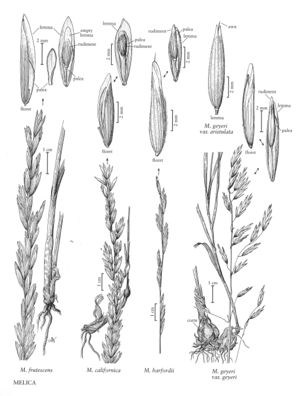Melica harfordii
Plants cespitose, not rhizomatous. Culms 35-120 cm, not forming corms; internodes smooth. Sheaths glabrous or pilose, often most pilose at the throat and collar; ligules 0.5-1.5 mm; blades 1.5-4.5 mm wide, abaxial surfaces smooth, adaxial surfaces scabridulous, glabrous or puberulent. Panicles 6-25 cm; branches 3-8 cm, appressed, with 2-6 spikelets; pedicels straight; disarticulation above the glumes. Spikelets 7-20 mm, with 2-6 bisexual florets; rachilla internodes 2-2.4 mm. Glumes obtuse to subacute; lower glumes 4-10 mm long, 1.5-2.5 mm wide, 3-5-veined; upper glumes 5-11 mm long, 1.8-2.5 mm wide, 5-7-veined; lemmas 6-16 mm, hairy, hairs to 0.75 mm on the back, 0.7-1.3 mm on the margins, 9-11-veined, veins inconspicuous, apices mucronate to rounded, usually awned, awns 0.5-3 mm, fragile; paleas about 3/4 as long as to nearly equaling the length of the lemmas; anthers 3, 2.2-4 mm; rudiments 2.5-6 mm, tapering, resembling the bisexual florets. Caryopses about 5 mm. 2n =18.
Distribution
Calif., Oreg., Wash., B.C.
Discussion
Melica harfordii grows primarily in the Pacific coast ranges from Washington to California, as well as in the Sierra Nevada and a few other inland locations, usually on dry slopes or in dry, open woods. The awns in M. harfordii often escape attention because they do not always extend beyond the lemma.
Selected References
None.
Lower Taxa
"decumbent" is not a number.
